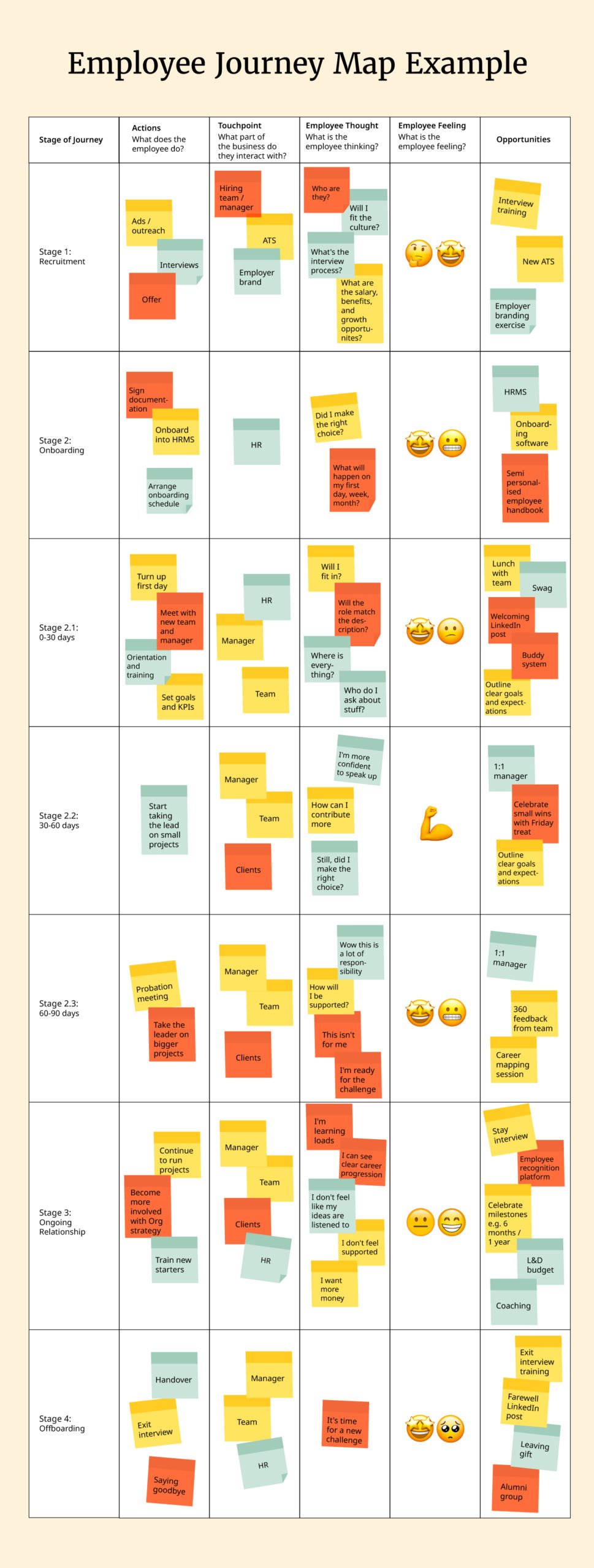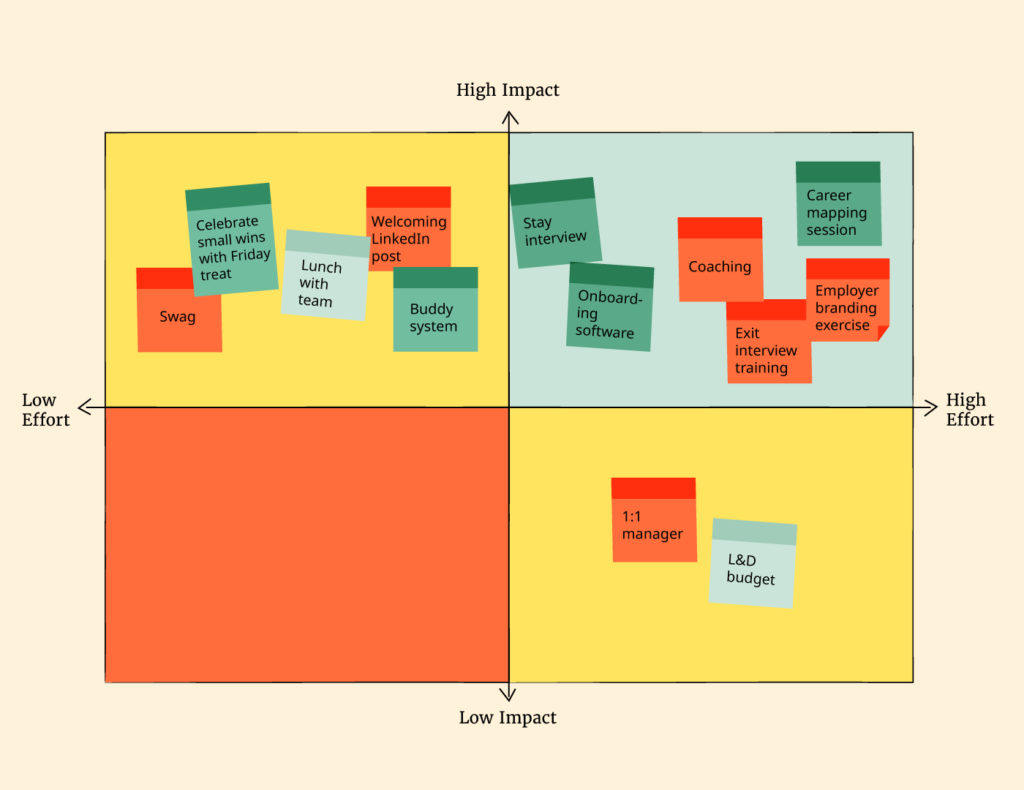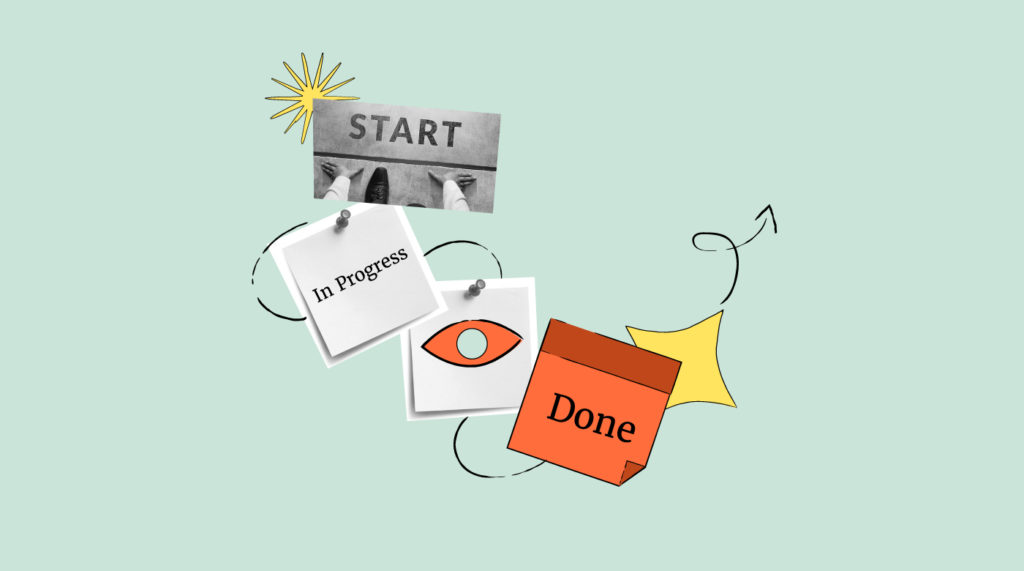We often build people and culture programs in a vacuum, without consulting the end user, then become disheartened when they fall flat.
But there’s a trick we can borrow from user and customer experience teams that will help us build better initiatives and invest in the appropriate employee engagement software.
I’ve been involved in the people world for around 20 years, and employee journey mapping is a tool I’ve adapted to help organizations create a better employee experience.
What Is The Employee Journey?
The employee journey, sometimes called the employee lifecycle, is a term that describes the different stages of employment an employee will go through during their time at an organization.
Employee journey stages
Commonly, the employee journey is separated into 6 stages that can be further divided for increased granularity.
- Attraction. Any interaction before a potential employee connects with you. This could be a media feature, LinkedIn post, or conversation over dinner.
- Recruitment. Your hiring process. Think candidate experience.
- Onboarding. Giving new employees the best possible start and setting them up for success at your company.
- Development. We want you to grow here. Covers performance management, training, and learning and development opportunities.
- Retention. Ensuring opportunities for career progression and looking after health and wellbeing.
- Offboarding. Saying goodbye but remaining friends.
What Is Employee Journey Mapping?
Employee journey mapping is a tool for thinking about how employees interact with the organization at each stage of the employee journey.
It encompasses forming a visual representation of the employee’s processes, needs, and perceptions throughout their interactions and relationships with the organization.
It’s used by human resources teams to identify pain points and design exemplary employee experiences.
"Hire to retire employee journey mapping is going to be a trend you'll see making a big impact on the employee experience in the next few years," says culture architect and remote work experience designer Darcy Marie Mayfield. "Some forward-thinking leaders are already doing this, but just as most customer-focused companies map their customer journey, more teams will be adopting the practice."
How To Run An Employee Journey Mapping Project
Here's a step-by-step process to conduct a successful employee journey mapping project.
1. Define the scope and objectives
- Identify goals: Determine what you aim to achieve with the employee journey mapping. This could be improving employee engagement, reducing turnover, or enhancing onboarding.
- Scope: Decide which parts of the employee lifecycle you want to focus on. It could be the entire lifecycle, but will likely be a specific stage like recruitment, onboarding, development.
2. Assemble a project team
- Cross-functional team: Include members from different departments such as HR, management, and direct supervisors.
- Employee representation: Consider including employees from various levels and roles to provide diverse perspectives.
3. Gather data
- Surveys and interviews: Conduct employee surveys and interviews with current employees to gather insights about their experiences.
- Review existing data: Look into performance reviews, exit interviews, and other HR metrics for additional insights.
- Observe: Observe the day-to-day experiences of employees in different roles.
4. Define employee personas
- Create personas: Develop representative personas of typical employees. This could be based on roles, career stages, demographics, etc.
- Understand needs and motivations: For each persona, understand their motivations, challenges, needs, and goals.
5. Map the employee journey
- Identify key phases: Break down the employee lifecycle into the key phases (e.g., recruitment, onboarding, development, retention, exit).
- Detail experiences in each phase: For each phase, map out the key experiences, touchpoints, emotions, and actions of the employees.
- Pain points and moments of truth: Identify any pain points and crucial moments that significantly impact the employee experience.
6. Analyze and identify opportunities
- Look for patterns: Identify common themes or issues across different personas and journey stages.
- Identify improvement areas: Pinpoint areas where changes or interventions could significantly improve the employee experience.
7. Develop action plans
- Strategize solutions: Based on your analysis, develop strategies to address the identified issues or enhance positive experiences.
- Set priorities: Prioritize actions based on their potential impact and feasibility.
8. Implement changes:
- Action implementation: Start implementing the planned changes, beginning with the highest-priority ones.
- Communicate with employees: Keep employees informed about the changes and the reasons behind them.
9. Monitor and adjust
- Feedback loop: Regularly collect feedback from employees on the implemented changes.
- Continuous improvement: Use the feedback to make continuous improvements to the employee experience.
10. Document and share insights
- Document the journey map: Create a visual representation of the employee journey map.
- Share with stakeholders: Share the journey map and insights with key stakeholders for broader understanding and support.
Remember, employee journey mapping is an iterative process requiring regular updates and revisions as the organization and workforce evolve.
By understanding and enhancing the employee experience at each stage, organizations can develop more impactful initiatives to improve the work environment.
Employee Journey Mapping Example
Recently, I worked on an employee journey mapping project with a client. They wanted to make sure they were hiring and retaining the right talent for a specific role within their organization.
If you were to use this for multiple roles or demographics, then you would create different employee personas for each role and plug them into your mapping process.
As in the UX and CX world, these personas are based on what you already know about people combined with employee feedback.
In this case, before we got to the mapping part, I began the process with ‘user’ interviews with 10 employees.
We used those interviews to map out what the value proposition was for those particular employees.
Essentially, that means mapping out things like what their needs and expectations are and what pleases/displeases them with questions such as:
- How did they hear about the company?
- What attracted them to work there?
- How is the experience of working there different than expected?
…and so on. I then mapped these learnings onto an empathy map (you can read about a similar process with empathy mapping in my recent post here).
From those interviews, we gained a basic understanding of the wants and needs of the group, and what their current issues might be.
We then took a smaller group of interested people from within the company to map it all out on an employee journey. You can see a rough version of what we created below.

If you want to consider something similar, first consider the different stages that are appropriate to you.
Then we took one stage at a time and asked:
- What does the employee do?
- Which parts of the team/organization do they interact with?
- What is the employee thinking?
- How is the employee feeling?
- What are our opportunities?
The opportunities section then becomes a bucket list of all the things you could do to craft a better employee experience. What are the opportunities available to support people to let them know you value them?
It could be as simple as a welcome gift, or by creating rigor around the way that people can progress within your organization.

This is a fairly recent project so, while many of the actions are still in flight, the team has already implemented a new recruitment system and improved the onboarding process for both sides using automation.
Benefits Of Employee Journey Mapping
Essentially, employee journey mapping helps you to improve the ‘product’ that employees subscribe to when they join your organization.
It’s very much in keeping with the burgeoning ‘people ops a product’ way of thinking about running HR teams.
Enhanced employee experience
Mapping the employee journey provides insights into key touchpoints and helps create a more tailored and positive work experience.
Actionable advice: Acknowledge that everyone is unique but journey mapping will help improve the overall experience for many new and existing employees.
Increased employee retention
By proactively addressing pain points and elevating positive aspects of the employee journey, organizations can significantly reduce turnover.
Actionable advice: Stay interviews and pulse surveys are effective methods to gather feedback from top talent to help improve their experience.
Better recruitment and onboarding
A well-defined employee journey helps ensure the effective integration of new hires into the company, fostering quicker productivity and alignment.
Actionable advice: Create a structured onboarding program with clear milestones such as a 30-60-90 day plan.
Data-driven insights for decision making
Employee journey mapping yields valuable data, enabling informed decision-making regarding HR policies and initiatives.
Actionable advice: leverage people analytics software to add further context to employee feedback and performance data.
Improved internal communication and collaboration
Understanding the employee journey can highlight areas for enhanced communication and collaboration, leading to a more cohesive workplace.
Actionable advice: Regularly post updates about your people initiatives to demonstrate action and encourage more and better feedback.
Employee Journey Mapping Best Practices
Identify ‘moments of truth’
Pay special attention to key moments that have a significant impact on the employee’s perception and loyalty. These could be moments of high satisfaction or critical pain points.
For example, someone’s first day is particularly emotional so it makes sense to mark this as a ‘moment of truth’
Gather multiple forms of feedback
Build a comprehensive employee listening strategy to gather feedback at various stages and implement changes based on feedback to improve the work experience.
This wil cover multiple forms of feedback and create an environment where employees feel safe to air grievances and contribute ideas.
Identify key touchpoints
Clearly define the touchpoints where employees interact with your org. This could include LinkedIn, careers sites, interviews, onboarding software, and your HRMS.
Continuous feedback and iteration
Regularly update the journey map based on continuous team member feedback and changing business landscape. A journey map should be a living document that evolves with your employees and your business.
Align with business objectives
Align insights from employee journey mapping process with overall business goals. The map should inform strategies that contribute to business growth and employee satisfaction.
Go Get Started With Employee Journey Mapping
Taking the time to get to know and consider the users you’re designing the employee experience for will help you craft a better employee experience.
The results will be higher levels of engagement, retention, and well-being.
Key takeaways
- Use employee journey mapping to better visualize and understand key emotions and touchpoints along the employee journey
- Collect rich and varied employee feedback to reduce reliance on assumptions and create better initiatives
- Your employee journey map is a living document that will evolve based on feedback and changes to the business landscape.
For further advice on journey mapping and creating exemplary employee experiences, join the People Managing People Community, a supportive community of HR and business leaders sharing knowledge to help you progress in your career and make greater impact in your org.


